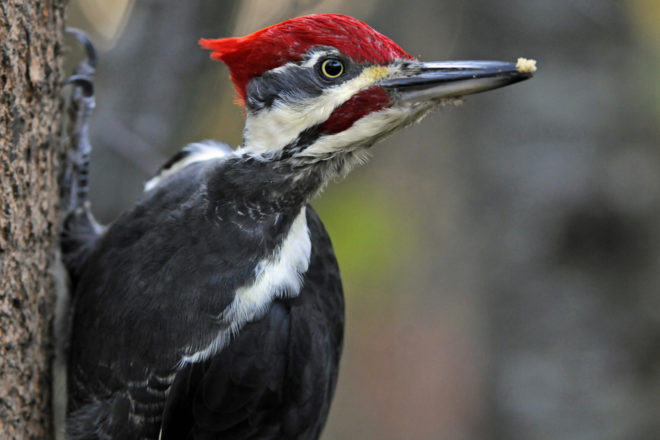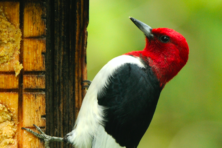DOOR TO NATURE: The Forest Excavator
- Share
- Tweet
- Pin
- Share

The largest woodpecker in our county leaves signs of its chisel work for hikers to see. This impressive red, white and black bird is nearly as big as the American crow. Its drumming on a tree trunk echoes throughout the woods. He is the dominant occupant of the suet and marvel meal feeders. All others must wait their turn.
There are four species of woodpeckers that live here all year: downy, hairy, red-bellied and pileated. We see three other species which migrate south in the winter and return in spring to nest here. Those are the red-headed woodpecker, common flicker and yellow-bellied sapsucker.
All of these play “second fiddle” to the pileated. This spectacular bird prefers to nest in large old trees. The female excavates a substantial cavity in which the young are raised. They breed in the North American forests ranging throughout southern Canada and most of the eastern half of the U.S.
The “pileys,” as we often call them, create large rectangular excavations in trees in search of carpenter ants, one of their favorite foods. The various holes left by their “woodworking” can be used by other birds like owls, swifts and ducks. Some may also be used as roosting sites by bats.
I feed birds all year long because I enjoy seeing the adults bring their youngsters in and feed them the marvel meal. In fact, that’s the first feeder the woodpeckers go to for good protein. When it is empty, they fly over to the suet cake in a hanging feeder.
Watching an adult pileated bring the marvel meal to its offspring makes one shudder in disbelief. The parent bird jabs its long beak into the gaping mouth of the youngster and drives it back and forth until the food is transferred. Looking at this you might wonder if the adult’s beak might come out of the back of the immature’s neck!
I’ve noticed that the adult male pileated has a yellow eye. A young, newly hatched female has a solid black or dark brown eye. It seems the eye color in females doesn’t become yellow until the second or third year.
People often ask, “How do you tell a male from a female pileated?”

The female piley shows its black forehead, dark eye and black cheek bar. Photo by Roy Lukes. 
This hardwood tree is a good exhibit of what a feeding pileated can do as it searches for carpenter ants. Photo by Roy Lukes.
A close look at the red crest shows that on the male it reaches all the way to the top of the beak. The female has a gray or black forehead with the red crest beginning at the middle of the top of her head.
Look at the cheeks of each and you will see that a male has red in the horizontal black line which runs from the bill back to the top of the neck. The female lacks this red cheek band. There are variations in the brilliance of the red on the side of the male’s face. Sometimes it is difficult to see the red on the male in dim light.
Numbers of pileated woodpeckers have increased over the last twenty years and it may be the invasion of the emerald ash borer that has helped. I have watched our resident piley strip vertical sections of bark off the large ash trees in my woods. This action reveals places where the invasive beetle has entered the tree, getting under the bark to lay its eggs.
The emerald ash borer is in the Buprestidae family, from the Greek “buprest,” meaning a beetle that is poisonous to cattle. This is a group of shiny wood-boring beetles that mostly affect deciduous trees.
I am seeing a greater number of downy and hairy woodpecker young each summer as well as more red-bellied woodpeckers. They are all benefitting from the emerald ash borer infections as more and more of the ash trees die each year.
The pileated woodpecker population declined during the big logging days in northern Wisconsin over a hundred years ago, but healthy second growth forests have developed and are being preserved to help these gigantic birds become re-established in three-quarters of the state. The only area with low numbers of pileys is the southeastern, urban part of Wisconsin.
My late husband Roy used to record animal and bird sound with a four-speed tape recorder. He was able to capture the sound of a pileated woodpecker doing its rapid, loud territorial rapping on a tree trunk. The sound lasted only a few seconds. When he played it back at a lower speed, we could count the number of times it hit the tree with its beak. It was 29!
Keep feeding all the birds in your neighborhood and listen for the rapping sound of the pileated. He is letting you know who is king of the woods!



